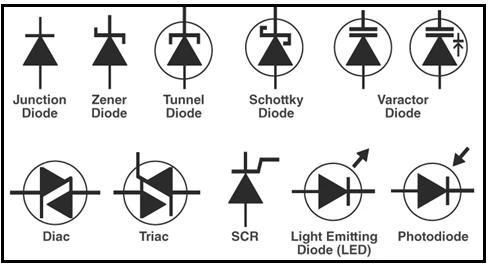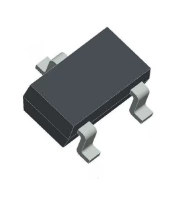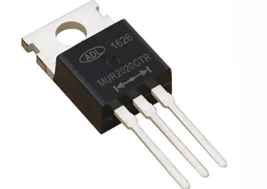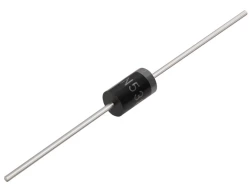The Difference Between A Diode And A Zener Diode
Diodes and Zener diodes both belong to semiconductor devices with unidirectional conductivity, but they differ fundamentally in structural design, operating mode, and practical applications. Ordinary diodes are primarily used for forward conduction, achieving the function of rectifying AC to DC; whereas Zener diodes are designed for reverse bias conditions, capable of stable conduction at specific voltages, making them key components in voltage regulation and circuit protection. They are crucial in applications requiring voltage stabilization and interference resistance.
What is a diode
A diode is an electronic component formed by doping semiconductor materials to create P-type and N-type regions on the same wafer. When forward-biased (with the P region connected to the positive terminal and the N region to the negative terminal), the PN junction conducts, allowing current to flow; when reverse-biased (with the P region connected to the negative terminal and the N region to the positive terminal), the PN junction is cut off, resulting in only a weak leakage current, thus achieving unidirectional current conduction.
Advantages and disadvantages of diodes
| class | merit | shortcoming |
| Core features | Unidirectional conductivity: the core function of rectification and anti-reverse protection. | Unidirectional conduction limitation: cannot be bidirectional, reverse path needs to be designed separately. |
| Efficiency and loss | Low on-state voltage drop: silicon tube 0.6-0.7V, Schottky tube 0.2-0.3V, static leakage current is very small. | Fixed voltage drop loss: the efficiency of low voltage circuit decreases, and heat is generated when the current is large, so heat dissipation is required. |
| switching performance | High speed switch: Schottky/fast recovery diode supports nanosecond switching and is suitable for high frequency circuits. | Reverse recovery time: high frequency applications of ordinary diodes produce loss and EMI noise. |
| temperature characteristic | Temperature sensing: positive pressure drop can be used for low cost temperature detection (-2mV/℃). | Temperature sensitive: leakage current increases at high temperature, and voltage drop drift affects circuit accuracy. |
| defencive function | Multi-function protection: voltage stabilization (Zener), surge protection (TVS), and continuous current protection for inductive loads. | Breakdown risk: reverse overvoltage is easy to permanent damage, additional protection circuit (such as TVS) is required. |
| current-illumination characteristic | High efficiency photoelectric conversion: LED has a long life (> 50,000 hours) and high light efficiency for lighting/communication. | Limitations of LED: it needs constant current drive, and the light efficiency decreases at high temperature. |
| Volume and cost | Miniaturization and low cost: SMD (surface mount packaging) is suitable for large-scale applications with unit price as low as cents. | Heat dissipation requirements: heat sink is required in high power scenarios, which increases the volume and cost. |
| Function expansion | Diverse types: rectifier tube, variable capacitance tube, laser tube and so on to meet the needs of different scenarios. | Single function: cannot amplify the signal, complex functions need to be combined with other components. |
| signal processing | High frequency support: PIN/Schottky diode is suitable for high frequency scenarios such as RF communication. | Nonlinear distortion: the volt-ampere characteristic is an exponential curve, resulting in analog signal distortion that needs to be compensated. |
Diode type

1. Rectifier diode



Rectifier diode: an electronic component that uses the unidirectional conductivity of a semiconductor PN junction to convert alternating current (AC) into direct current (DC).
Schottky diode: is a diode based on metal-semiconductor junction (Schottky barrier), its core characteristics are low forward voltage drop and ultra-fast switching speed, widely used in high frequency, low voltage and high efficiency circuits.
Fast recovery diode: a diode that optimizes reverse recovery time, designed for high frequency switching circuits, with both fast turn-off capability and high voltage endurance characteristics.
2. Protective diode
Zener diode: a semiconductor device that uses the reverse breakdown characteristic to achieve voltage stability. By precisely controlling the breakdown voltage (Zener voltage), it provides a reference voltage or overvoltage protection function in the circuit.
TVS diode: is a semiconductor device dedicated to protect transient overvoltage. It protects the back-end circuit by quickly clamping high voltage pulses, and is widely used to deal with ESD (electrostatic discharge), lightning surge, inductive load switching and other transient interference.
3. Signal processing diodes
Variable capacitance diode: it is a semiconductor device based on the reverse bias voltage to adjust the junction capacitance, and is specially used to realize the variable capacitance function of electronic tuning, frequency modulation and other voltage control.
PIN diode: A special structure of semiconductor diode, its name comes from its material zone structure: P type (positive doping area), I type (intrinsic semiconductor area) and N type (negative doping area).
4. Photoelectric diodes
Light-emitting diode: a semiconductor PN junction device that can directly convert electrical energy into light energy.
Laser diode: a solid state laser device that uses the semiconductor PN junction to generate stimulated radiation in the active region and achieve optical amplification through the feedback of the resonant cavity.
5. Special function diodes
Tunnel diode: Also known as the Esaaki diode (Esaki Diode), it is a high-speed semiconductor diode that works by quantum tunneling.
Snow avalanche diode: a semiconductor device that uses the avalanche breakdown effect of the PN junction under high reverse bias.
| type | Core features | Typical model | Main application scenarios |
| commutation diode | -High voltage and high current (1A to dozens of A) -Slow reverse recovery time (μs class) | 1N4007, 1N5408 | Power adapter, industrial frequency rectifier circuit |
| Schottky diode | -Ultra low on-state voltage drop (0.2-0.3V) -Very short reverse recovery time (ns level) -Low reverse pressure resistance | 1N5819, BAT54 | High frequency switching power supply, anti-reverse protection, low voltage high efficiency rectification |
| Fast recovery diode | -Short reverse recovery time (ns~μs level) -High pressure resistance (hundreds of V~kV) | FR107, UF4007 | High frequency inverter, switching power supply, PWM circuit |
| Zener diode (Zener) | -Reverse breakdown voltage regulator (2.4V~200V) -Need to limit the current resistance | 1N4728A (3.3V), BZX55C | Voltage reference, overvoltage protection, simple voltage regulator circuit |
| TVS diode | -Transient high voltage absorption (nanosecond response) -High power (hundreds of W ~ kW) | P6KE series, SMAJ series | Lightning protection, ESD protection, power port surge protection |
| Light-emitting diode (LED) | -Conversion of electrical energy to light energy (visible/infrared) -Constant current drive is required | CREE XHP70, IR204 | Lighting, display, indicator, optical communication |
| variode | -The capacitance varies with the reverse voltage (pF level) -Good high frequency characteristics | BBY40, 1N5450 | Tuning circuit (radio, VCO), voltage controlled filter |
| PIN diode | -Excellent high frequency characteristics (GHz class) -Adjustable resistance characteristics (forward current control) | HPND-4008, MA4P series | Radio frequency switch, microwave attenuator, optical communication receiving module |
| tunnel diode | -Negative resistance characteristics (high frequency oscillation) -Ultra high speed (ps class) | 1N3716, TD-261 | High frequency oscillator, low noise amplifier (radar, communication) |
| laser diode | -High coherence monochromatic light output -Precise temperature control and drive are required | HL7851G, DFB-1550 | Fiber optic communication, laser printer, optical storage equipment (CD/DVD) |
| avalanche diode | -Take advantage of avalanche penetration -Generation of high frequency, high voltage pulses | ZPY series, SA5.0 | Microwave communication, particle detector, high voltage pulse generator |
What is a Zener diode

It is a semiconductor device that uses the breakdown characteristics of the PN junction to stabilize the voltage. It usually works in reverse bias and maintains a nearly constant stable voltage.
Advantages and disadvantages of Zener diodes
| Parameter dimension | merit | shortcoming | remarks |
| Structure and cost | Simple structure, mature PN junction process; small package, low production cost | — | Suitable for mass production and cost sensitive applications |
| response speed | The tunneling/avalanche breakdown occurs instantaneously and the response time can reach nanosecond level | — | Suitable for scenarios requiring rapid voltage stabilization or limiting |
| Stabilization performance | Within the specified breakdown current range, the output voltage fluctuates little; the dynamic impedance is low, which can effectively suppress the power supply ripple | The voltage regulation accuracy is limited, and the long-term drift is large, which is not as good as the integrated linear regulator or precision reference source | Suitable for coarse voltage stabilization or reference base, non-high precision occasions |
| Voltage option range | Breakdown voltage can be designed from about 2.4V to hundreds of volts | — | It covers almost all small power DC voltage regulation requirements |
| Power/current | — | Small packages (0.25W–0.5W) have limited current carrying and heat dissipation capacity; high power requires larger packages or additional heat dissipation | The appropriate package or parallel use should be selected according to the application power consumption |
| temperature characteristic | — | The temperature coefficient is between-2 mV/℃ and +2 mV/℃; the low pressure area (tunneling) has a negative temperature coefficient, and the high pressure area (avalanche) has a positive temperature coefficient, requiring temperature compensation | Temperature drift may affect the accuracy, so temperature compensation scheme should be considered in the design |
| noise characteristic | — | The noise generated by tunneling and avalanche process is higher than that of the dedicated low noise voltage regulator | Not suitable for ultra-low noise precision analog circuit |
| productiveness | — | Working in the breakdown region, excess voltage is wasted in the form of heat and the efficiency is low | Power sensitive portable devices need to be selected carefully |